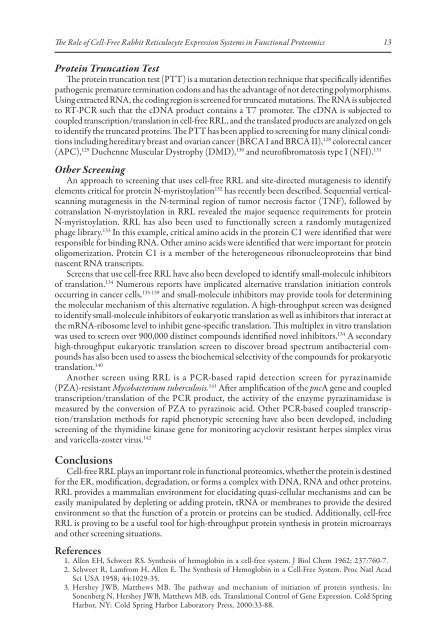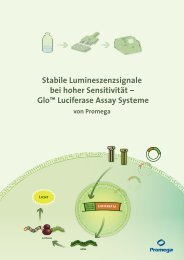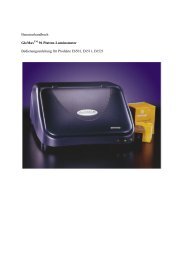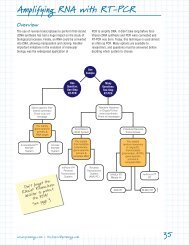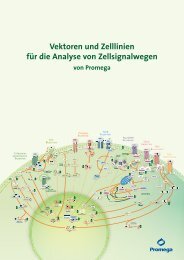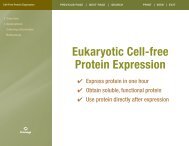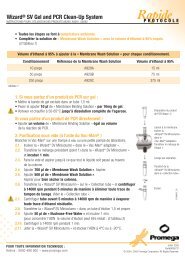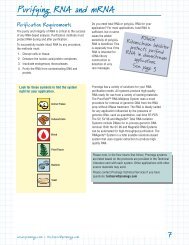The Role of Cell-Free Rabbit Reticulocyte Expression ... - Promega
The Role of Cell-Free Rabbit Reticulocyte Expression ... - Promega
The Role of Cell-Free Rabbit Reticulocyte Expression ... - Promega
You also want an ePaper? Increase the reach of your titles
YUMPU automatically turns print PDFs into web optimized ePapers that Google loves.
<strong>The</strong> <strong>Role</strong> <strong>of</strong> <strong>Cell</strong>-<strong>Free</strong> <strong>Rabbit</strong> <strong>Reticulocyte</strong> <strong>Expression</strong> Systems in Functional Proteomics<br />
Protein Truncation Test<br />
<strong>The</strong> protein truncation test (PTT) is a mutation detection technique that specifically identifies<br />
pathogenic premature termination codons and has the advantage <strong>of</strong> not detecting polymorphisms.<br />
Using extracted RNA, the coding region is screened for truncated mutations. <strong>The</strong> RNA is subjected<br />
to RT‑PCR such that the cDNA product contains a T7 promoter. <strong>The</strong> cDNA is subjected to<br />
coupled transcription/translation in cell‑free RRL, and the translated products are analyzed on gels<br />
to identify the truncated proteins. <strong>The</strong> PTT has been applied to screening for many clinical condi‑<br />
tions including hereditary breast and ovarian cancer (BRCA I and BRCA II), 128 colorectal cancer<br />
(APC), 129 Duchenne Muscular Dystrophy (DMD), 130 and neur<strong>of</strong>ibromatosis type I (NFI). 131<br />
Other Screening<br />
An approach to screening that uses cell‑free RRL and site‑directed mutagenesis to identify<br />
elements critical for protein N‑myristoylation 132 has recently been described. Sequential vertical‑<br />
scanning mutagenesis in the N‑terminal region <strong>of</strong> tumor necrosis factor (TNF), followed by<br />
cotranslation N‑myristoylation in RRL revealed the major sequence requirements for protein<br />
N‑myristoylation. RRL has also been used to functionally screen a randomly mutagenized<br />
phage library. 133 In this example, critical amino acids in the protein C1 were identified that were<br />
responsible for binding RNA. Other amino acids were identified that were important for protein<br />
oligomerization. Protein C1 is a member <strong>of</strong> the heterogeneous ribonucleoproteins that bind<br />
nascent RNA transcripts.<br />
Screens that use cell‑free RRL have also been developed to identify small‑molecule inhibitors<br />
<strong>of</strong> translation. 134 Numerous reports have implicated alternative translation initiation controls<br />
occurring in cancer cells, 135‑139 and small‑molecule inhibitors may provide tools for determining<br />
the molecular mechanism <strong>of</strong> this alternative regulation. A high‑throughput screen was designed<br />
to identify small‑molecule inhibitors <strong>of</strong> eukaryotic translation as well as inhibitors that interact at<br />
the mRNA‑ribosome level to inhibit gene‑specific translation. This multiplex in vitro translation<br />
was used to screen over 900,000 distinct compounds identified novel inhibitors. 134 A secondary<br />
high‑throughput eukaryotic translation screen to discover broad spectrum antibacterial com‑<br />
pounds has also been used to assess the biochemical selectivity <strong>of</strong> the compounds for prokaryotic<br />
translation. 140<br />
Another screen using RRL is a PCR‑based rapid detection screen for pyrazinamide<br />
(PZA)‑resistant Mycobacterium tuberculosis. 141 After amplification <strong>of</strong> the pncA gene and coupled<br />
transcription/translation <strong>of</strong> the PCR product, the activity <strong>of</strong> the enzyme pyrazinamidase is<br />
measured by the conversion <strong>of</strong> PZA to pyrazinoic acid. Other PCR‑based coupled transcrip‑<br />
tion/translation methods for rapid phenotypic screening have also been developed, including<br />
screening <strong>of</strong> the thymidine kinase gene for monitoring acyclovir resistant herpes simplex virus<br />
and varicella‑zoster virus. 142<br />
Conclusions<br />
<strong>Cell</strong>‑free RRL plays an important role in functional proteomics, whether the protein is destined<br />
for the ER, modification, degradation, or forms a complex with DNA, RNA and other proteins.<br />
RRL provides a mammalian environment for elucidating quasi‑cellular mechanisms and can be<br />
easily manipulated by depleting or adding protein, tRNA or membranes to provide the desired<br />
environment so that the function <strong>of</strong> a protein or proteins can be studied. Additionally, cell‑free<br />
RRL is proving to be a useful tool for high‑throughput protein synthesis in protein microarrays<br />
and other screening situations.<br />
References<br />
1. Allen EH, Schweet RS. Synthesis <strong>of</strong> hemoglobin in a cell‑free system. J Biol Chem 1962; 237:760‑7.<br />
2. Schweet R, Lamfrom H, Allen E. <strong>The</strong> Synthesis <strong>of</strong> Hemoglobin in a <strong>Cell</strong>‑<strong>Free</strong> System. Proc Natl Acad<br />
Sci USA 1958; 44:1029‑35.<br />
3. Hershey JWB, Matthews MB. <strong>The</strong> pathway and mechanism <strong>of</strong> initiation <strong>of</strong> protein synthesis. In:<br />
Sonenberg N, Hershey JWB, Matthews MB, eds. Translational Control <strong>of</strong> Gene <strong>Expression</strong>. Cold Spring<br />
Harbor, NY: Cold Spring Harbor Laboratory Press, 2000:33‑88.<br />
1


